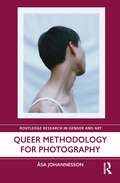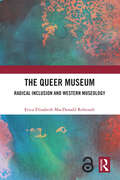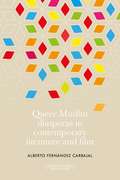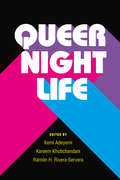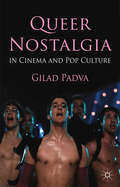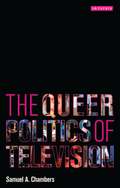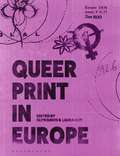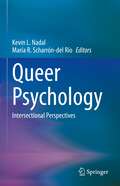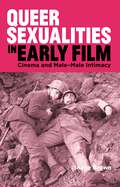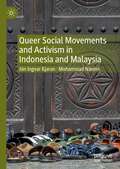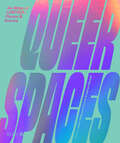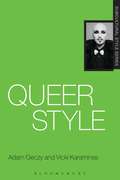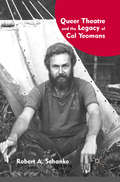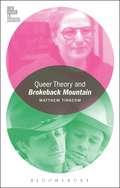- Table View
- List View
Queer Methodology for Photography (Routledge Research in Gender and Art)
by Asa JohannessonThis book presents new ways of approaching photographic discourse from a queer perspective, offering discussions on what a queering methodology for photography may entail by drawing links between artistic strategies in photographic practice and key theoretical concepts from photography theory, queer theory, critical theory, and philosophy. With different examples of conceptual perspectives, including representation, formalism, and mediumlessness, it seeks to diversify queer methodology for photography. While primarily addressing photography, this book is entwined with broader philosophical questions concerning identity, difference, and the creations of systems of thought that limit the possibilities of existence to binary categorisation. It proposes a new concept of the photographic image that addresses its materiality, in the form of the poetic and the political, in relationship to a generative principle that is named as a queer quality: the photograph’s ability to voice queer concerns also beyond its role as representation. This book will be of interest to scholars working in photography, art history, queer studies, new materialism, and posthumanism.
Queer Methodology for Photography (Routledge Research in Gender and Art)
by Asa JohannessonThis book presents new ways of approaching photographic discourse from a queer perspective, offering discussions on what a queering methodology for photography may entail by drawing links between artistic strategies in photographic practice and key theoretical concepts from photography theory, queer theory, critical theory, and philosophy. With different examples of conceptual perspectives, including representation, formalism, and mediumlessness, it seeks to diversify queer methodology for photography. While primarily addressing photography, this book is entwined with broader philosophical questions concerning identity, difference, and the creations of systems of thought that limit the possibilities of existence to binary categorisation. It proposes a new concept of the photographic image that addresses its materiality, in the form of the poetic and the political, in relationship to a generative principle that is named as a queer quality: the photograph’s ability to voice queer concerns also beyond its role as representation. This book will be of interest to scholars working in photography, art history, queer studies, new materialism, and posthumanism.
The Queer Museum: Radical Inclusion and Western Museology
by Erica RobenaltThe Queer Museum examines how relationships between institutions and LGBTQ+ communities function and how they help to define queer museum practice.Analysing what it means to queer the museum in Western contexts, the book builds upon and challenges texts about inclusionary, activist museum practice and discusses the ways in which Othered communities are engaged with and represented. Arguing that an institution’s understanding of queerness is directly related to the kind, and extent, of change pursued by the museum, the author clarifies that governance structures, staff hierarchies, funding and relationships to queer communities affect the way queering might be pursued. The analysis looks critically at exhibitions and institutions and particularly forefronts the experiences of museum practitioners. It argues that practical changes that positively affect museums’ long-term relationships with marginalised communities are critical. The book also considers the future of the museum by drawing on queer theories of utopia, futurity, failure and amateurism to complicate understandings of the queer museum and its relationship to people and objects.The Queer Museum will be of interest to students and academics in museum and heritage studies, art history and archival studies. It will also be essential reading for museum and arts sector practitioners who seek to do and engage with this kind of work.
The Queer Museum: Radical Inclusion and Western Museology
by Erica RobenaltThe Queer Museum examines how relationships between institutions and LGBTQ+ communities function and how they help to define queer museum practice.Analysing what it means to queer the museum in Western contexts, the book builds upon and challenges texts about inclusionary, activist museum practice and discusses the ways in which Othered communities are engaged with and represented. Arguing that an institution’s understanding of queerness is directly related to the kind, and extent, of change pursued by the museum, the author clarifies that governance structures, staff hierarchies, funding and relationships to queer communities affect the way queering might be pursued. The analysis looks critically at exhibitions and institutions and particularly forefronts the experiences of museum practitioners. It argues that practical changes that positively affect museums’ long-term relationships with marginalised communities are critical. The book also considers the future of the museum by drawing on queer theories of utopia, futurity, failure and amateurism to complicate understandings of the queer museum and its relationship to people and objects.The Queer Museum will be of interest to students and academics in museum and heritage studies, art history and archival studies. It will also be essential reading for museum and arts sector practitioners who seek to do and engage with this kind of work.
Queer Muslim diasporas in contemporary literature and film (Multicultural Textualities)
by Alberto Fernández CarbajalThis book explores the representation of queer migrant Muslims in international literature and film from the 1980s to the present day. Bringing together a variety of contemporary writers and filmmakers of Muslim heritage engaged in vindicating same-sex desire, the book approaches queer Muslims in the diaspora as figures forced to negotiate their identities according to the expectations of the West and of their migrant Muslim communities. The book examines 3 main themes: the depiction of queer desire across racial and national borders, the negotiation of Islamic femininities and masculinities, and the positioning of the queer Muslim self in time and place. This study will be of interest to scholars, as well as to advanced general readers and postgraduate students, interested in Muslims, queerness, diaspora and postcolonialism. It brings nuance and complexity to an often simplified and controversial topic.
Queer Muslim diasporas in contemporary literature and film (Multicultural Textualities)
by Alberto Fernández CarbajalThis book explores the representation of queer migrant Muslims in international literature and film from the 1980s to the present day. Bringing together a variety of contemporary writers and filmmakers of Muslim heritage engaged in vindicating same-sex desire, the book approaches queer Muslims in the diaspora as figures forced to negotiate their identities according to the expectations of the West and of their migrant Muslim communities. The book examines 3 main themes: the depiction of queer desire across racial and national borders, the negotiation of Islamic femininities and masculinities, and the positioning of the queer Muslim self in time and place. This study will be of interest to scholars, as well as to advanced general readers and postgraduate students, interested in Muslims, queerness, diaspora and postcolonialism. It brings nuance and complexity to an often simplified and controversial topic.
Queer Nightlife (Triangulations: Lesbian/Gay/Queer Theater/Drama/Performance)
by Ramon Rivera-Servera Kareem Khubchandani Kemi AdeyemiThe mass shooting at a queer Latin Night in Orlando in July 2016 sparked a public conversation about access to pleasure and selfhood within conditions of colonization, violence, and negation. Queer Nightlife joins this conversation by centering queer and trans people of color who apprehend the risky medium of the night to explore, know, and stage their bodies, genders, and sexualities in the face of systemic and social negation. The book focuses on house parties, nightclubs, and bars that offer improvisatory conditions and possibilities for “stranger intimacies,” and that privilege music, dance, and sexual/gender expressions. Queer Nightlife extends the breadth of research on “everynight life” through twenty-five essays and interviews by leading scholars and artists. The book’s four sections move temporally from preparing for the night (how do DJs source their sounds, what does it take to travel there, who promotes nightlife, what do people wear?); to the socialities of nightclubs (how are social dance practices introduced and taught, how is the price for sex negotiated, what styles do people adopt to feel and present as desirable?); to the staging and spectacle of the night (how do drag artists confound and celebrate gender, how are spaces designed to create the sensation of spectacularity, whose bodies become a spectacle already?); and finally, how the night continues beyond the club and after sunrise (what kinds of intimacies and gestures remain, how do we go back to the club after Orlando?).
Queer Nostalgia in Cinema and Pop Culture
by Gilad PadvaQueer Nostalgia in Cinema and Pop Culture is a fascinating study of queer nostalgia in films, animation and music videos as means of empowerment, re-evaluating and recreating lost gay youth, coming to terms with one's sexual otherness and homoerotic desires, and creatively challenging homophobia, chauvinism, ageism and racism.
Queer Performance and Contemporary Ireland: Dissent and Disorientation (Contemporary Performance InterActions)
by Fintan WalshThis book examines the surge of queer performance produced across Ireland since the first stirrings of the Celtic Tiger in the mid-1990s, up to the passing of the Marriage Equality referendum in the Republic in 2015.
The Queer Politics of Television (Reading Contemporary Television)
by Samuel A. ChambersThe Queer Politics of Television is a radical book, which brings together the fields of political theory and television studies. In one of the first books to do so, Samuel A Chambers exposes and explores the cultural politics of television by treating television shows - including 'Six Feet Under', 'Buffy the Vampire Slayer', 'Desperate Housewives', 'The L Word', and 'Big Love' - as serious, important texts and reading them in detail through the lens of queer theory.Chambers makes the case for the profound significance of 'the cultural politics of television', the way in which a television show's text itself engages with the politics of its day. He argues for queer theory's essential contribution to any understanding of the political, and initiates a larger project of queer television studies, treading the same path as queer film studies. This book makes an important and fresh contribution to queer theory and to the understanding of television as politics.
Queer Print in Europe
by Glyn Davis and Laura GuyHow have radical print cultures fostered and preserved queer lived experience from the 1960s to the present? What alternative stories about queer life across Europe can visual material reveal? Queer Print in Europe is the first book devoted to the exploration of queer print cultures in Europe, following the birth of an international gay rights movement in the late 1960s. By unearthing these ephemeral paper documents from archives and personal collections, including materials that have been out of circulation since they were first distributed, this book examines how the production and dissemination of queer print intersected with the emergence of LGBTQ+ activism within specific national contexts. This vital contribution to queer history explores borders and political movements, and the ways in which these materials contributed, through their international circulation, to the creation of a 'post-national' queer community.Illustrated throughout with examples of manifestos, flyers, posters, zines and other forms of print media, it features interviews with those responsible for making, distributing or archiving queer print, alongside a series of new theoretical essays that set particular publications and the individuals and groups that produced them in context. The book isolates specific instances of queer print media and scrutinises their design aesthetics, identifying both the significant contribution that queer print has made to histories of LGBTQ+ struggle and to the history of print design.
Queer Print in Europe
How have radical print cultures fostered and preserved queer lived experience from the 1960s to the present? What alternative stories about queer life across Europe can visual material reveal? Queer Print in Europe is the first book devoted to the exploration of queer print cultures in Europe, following the birth of an international gay rights movement in the late 1960s. By unearthing these ephemeral paper documents from archives and personal collections, including materials that have been out of circulation since they were first distributed, this book examines how the production and dissemination of queer print intersected with the emergence of LGBTQ+ activism within specific national contexts. This vital contribution to queer history explores borders and political movements, and the ways in which these materials contributed, through their international circulation, to the creation of a 'post-national' queer community.Illustrated throughout with examples of manifestos, flyers, posters, zines and other forms of print media, it features interviews with those responsible for making, distributing or archiving queer print, alongside a series of new theoretical essays that set particular publications and the individuals and groups that produced them in context. The book isolates specific instances of queer print media and scrutinises their design aesthetics, identifying both the significant contribution that queer print has made to histories of LGBTQ+ struggle and to the history of print design.
Queer Psychology: Intersectional Perspectives
by Kevin L. Nadal María R. Scharrón-del RíoQueer Psychology is the first comprehensive book to examine the current state of LGBTQ communities and psychology, through the lenses of both queer theory and Intersectionality theory. Thus, the book describes the experiences of LGBTQ people broadly, while also highlighting the voices of LGBTQ people of color, transgender and gender nonconforming people, those of religious minority groups, immigrants, people with disabilities, and other historically marginalized groups. Each chapter will include an intersectional case example, as well as implications for policy and practice.This book is especially important as there has been an increase in psychology and counseling courses focusing on LGBTQ communities; however, students often learn about LGBTQ-related issues through a White cisgender male normative perspective. The edited volume contains the contributions of leading scholars in LGBTQ psychology, and covers a number of concepts – ranging from identity development to discrimination to health.
Queer Sexualities in Early Film: Cinema and Male-Male Intimacy (Library of Gender and Popular Culture)
by Shane BrownSince the publication of Vito Russo's seminal study The Celluloid Closet in 1981, much has been written about the representation of queer characters on screen. Until now, however, relatively little attention has been paid to how queer sexualities were portrayed in films from the silent and early sound period. By looking in detail at a succession of recently-found films and revisiting others, Shane Brown examines images of male-male intimacy, buddy relationships and romantic friendships in European and American films made prior to 1934, including Different from the Others and All Quiet on the Western Front. He places these films within their socio-political and scientific context and sheds new light on how they were intended to be viewed and how they were actually perceived. In doing so, Brown offers his readers a unique insight into a little known area of early cinema, queer studies and social history.
The Queer Sixties
by Patricia Juliana SmithThe Queer Sixties assembles an impressive group of cultural critics to go against the grain of 1960s studies, and proposes new and different ways of the last decade before the closet doors swung open. Imbued with the zeitgeist of the 60s, this playful and powerful collection rescues the persistence of the queer imaginary.
The Queer Sixties
by Patricia Juliana SmithThe Queer Sixties assembles an impressive group of cultural critics to go against the grain of 1960s studies, and proposes new and different ways of the last decade before the closet doors swung open. Imbued with the zeitgeist of the 60s, this playful and powerful collection rescues the persistence of the queer imaginary.
Queer Social Movements and Activism in Indonesia and Malaysia
by Jón Ingvar Kjaran Mohammad NaeimiThis book examines queer activism and queer social movements (QSMs) in Indonesia and Malaysia, broadly engaging with these topics on three different levels: macro (global and national discourses), meso (organizational level – activities), and micro (individual – the activist). The micro level perspective allows for moving beyond the “traditional” political movement paradigm by understanding activism in Foucauldian terms as the ethics of the self (Foucault, 1984). In other words, the queer subject is seen as an active agent in taking care of the self by queering/resisting gender norms as well as heteronormative practices and regimes in their social environment through embodiment and actions. This kind of ethical being has the potential to build support and community between and amongst individuals.
Queer Spaces: An Atlas of LGBTQ+ Places and Stories
by Adam Nathaniel Furman Joshua MardellAn independent bookshop in Glasgow. An ice cream parlour in Havana, where strawberry is the queerest choice. A cathedral in ruins in Managua, occupied by the underground LGBTQIA+ community. Queer people have always found ways to exist and be together, and there will always be a need for queer spaces. In this lavishly illustrated volume, Adam Nathaniel Furman and Joshua Mardell have gathered together a community of contributors to share stories of spaces that range from the educational to the institutional to the re-appropriated, and many more besides. With historic, contemporary and speculative examples from around the world, Queer Spaces recognises LGBTQIA+ life past and present as strong, vibrant, vigorous, and worthy of its own place in history. Looking forward, it suggests visions of what form these spaces may take in the future to continue uplifting queer lives. Featured spaces include: Black Lesbian and Gay Centre, London Category Is Books, Glasgow Christopher Street, New York Coppelia, Havana New Sazae, Tokyo ONE Institute for Homophile Studies, Los Angeles Pop-Up spaces, Dhaka Queer House Party, Online Santiago Apóstol Cathedral, Managua Trans Memory Archive, Buenos Aires Victorian Pride Centre, Melbourne
Queer Spaces: An Atlas of LGBTQ+ Places and Stories
by Adam Nathaniel Furman Joshua MardellAn independent bookshop in Glasgow. An ice cream parlour in Havana, where strawberry is the queerest choice. A cathedral in ruins in Managua, occupied by the underground LGBTQIA+ community. Queer people have always found ways to exist and be together, and there will always be a need for queer spaces. In this lavishly illustrated volume, Adam Nathaniel Furman and Joshua Mardell have gathered together a community of contributors to share stories of spaces that range from the educational to the institutional to the re-appropriated, and many more besides. With historic, contemporary and speculative examples from around the world, Queer Spaces recognises LGBTQIA+ life past and present as strong, vibrant, vigorous, and worthy of its own place in history. Looking forward, it suggests visions of what form these spaces may take in the future to continue uplifting queer lives. Featured spaces include: Black Lesbian and Gay Centre, London Category Is Books, Glasgow Christopher Street, New York Coppelia, Havana New Sazae, Tokyo ONE Institute for Homophile Studies, Los Angeles Pop-Up spaces, Dhaka Queer House Party, Online Santiago Apóstol Cathedral, Managua Trans Memory Archive, Buenos Aires Victorian Pride Centre, Melbourne
Queer Style (Subcultural Style)
by Adam Geczy Vicki KaraminasQueer Style offers an insight into queer fashionability by addressing the role that clothing has played in historical and contemporary lifestyles. From a fashion studies perspective, it examines the function of subcultural dress within queer communities and the mannerisms and messages that are used as signifiers of identity. Diverse dress is examined, including effeminate 'pansy,' masculine macho 'clone,' the 'lipstick' and 'butch' lesbian styles and the extreme styles of drag kings and drag queens. Divided into three main sections on history, subcultural identity and subcultural style, Queer Style will be of particular interest to students of dress and fashion as well as those coming to subculture from sociology and cultural studies.
Queer Style (Subcultural Style)
by Adam Geczy Vicki KaraminasQueer Style offers an insight into queer fashionability by addressing the role that clothing has played in historical and contemporary lifestyles. From a fashion studies perspective, it examines the function of subcultural dress within queer communities and the mannerisms and messages that are used as signifiers of identity. Diverse dress is examined, including effeminate 'pansy,' masculine macho 'clone,' the 'lipstick' and 'butch' lesbian styles and the extreme styles of drag kings and drag queens. Divided into three main sections on history, subcultural identity and subcultural style, Queer Style will be of particular interest to students of dress and fashion as well as those coming to subculture from sociology and cultural studies.
Queer Style: Revised and Updated Edition
by Adam Geczy Vicki KaraminasFirst published in 2013, Queer Style was ahead of its time. It was the first book to address the cultural, political, and material histories of clothes as signs and markers of gender and sexual identity, and remains key reading for scholars and students across fashion studies and the humanities more broadly. Now, 10 years later, the authors have revisited their classic work and updated it to examine the function of subcultural dress within queer communities and the mannerisms and messages that are used as signifiers of identity.
Queer Theatre and the Legacy of Cal Yeomans
by R. SchankeA forgotten yet award-winning playwright, Cal Yeomans was one of the founders of gay theater whose work was fueled by gay liberation and extinguished by the AIDS epidemic. Schanke's examination of his life and legacy allows a rare exploration into this pivotal moment of gay American history.
Queer Theory and Brokeback Mountain (Film Theory in Practice)
by Matthew TinkcomQueer Theory and Brokeback Mountain examines queer theory as it has emerged in the past three decades and discusses how Brokeback Mountain can be understood through the terms of this field of scholarship and activism. Organized into two parts, in the first half the author discusses key canonical texts within queer theory, including the work of writers as Judith Butler, Michel Foucault, and Eve Kosofsky Sedgwick. He provides an historical account of the questions these scholars have posed to our understanding of sexualities-both normative and non-normative-in the historical past and in contemporary life, as well as a discussion of the theories of sexuality and gender offered by these scholars as these phenomena shape the experiences of men and women in the genital, bodily, erotic, discursive, and cultural dimensions.The second part examines Ang Lee's 2005 feature film, Brokeback Mountain, in order to understand the claims and insights of queer theory. Tracing the film's adaptation by screenwriter Larry McMurtry of Annie Proulx's 1997 short story of the same title, this portion of the book examines the film's narrative about two working-class men in the rural mid-20th-century U.S. and the meanings of the sexual and emotional bond between the pair that develops over the course of two decades.
Queer Theory and Brokeback Mountain (Film Theory in Practice)
by Matthew TinkcomQueer Theory and Brokeback Mountain examines queer theory as it has emerged in the past three decades and discusses how Brokeback Mountain can be understood through the terms of this field of scholarship and activism. Organized into two parts, in the first half the author discusses key canonical texts within queer theory, including the work of writers as Judith Butler, Michel Foucault, and Eve Kosofsky Sedgwick. He provides an historical account of the questions these scholars have posed to our understanding of sexualities-both normative and non-normative-in the historical past and in contemporary life, as well as a discussion of the theories of sexuality and gender offered by these scholars as these phenomena shape the experiences of men and women in the genital, bodily, erotic, discursive, and cultural dimensions.The second part examines Ang Lee's 2005 feature film, Brokeback Mountain, in order to understand the claims and insights of queer theory. Tracing the film's adaptation by screenwriter Larry McMurtry of Annie Proulx's 1997 short story of the same title, this portion of the book examines the film's narrative about two working-class men in the rural mid-20th-century U.S. and the meanings of the sexual and emotional bond between the pair that develops over the course of two decades.
